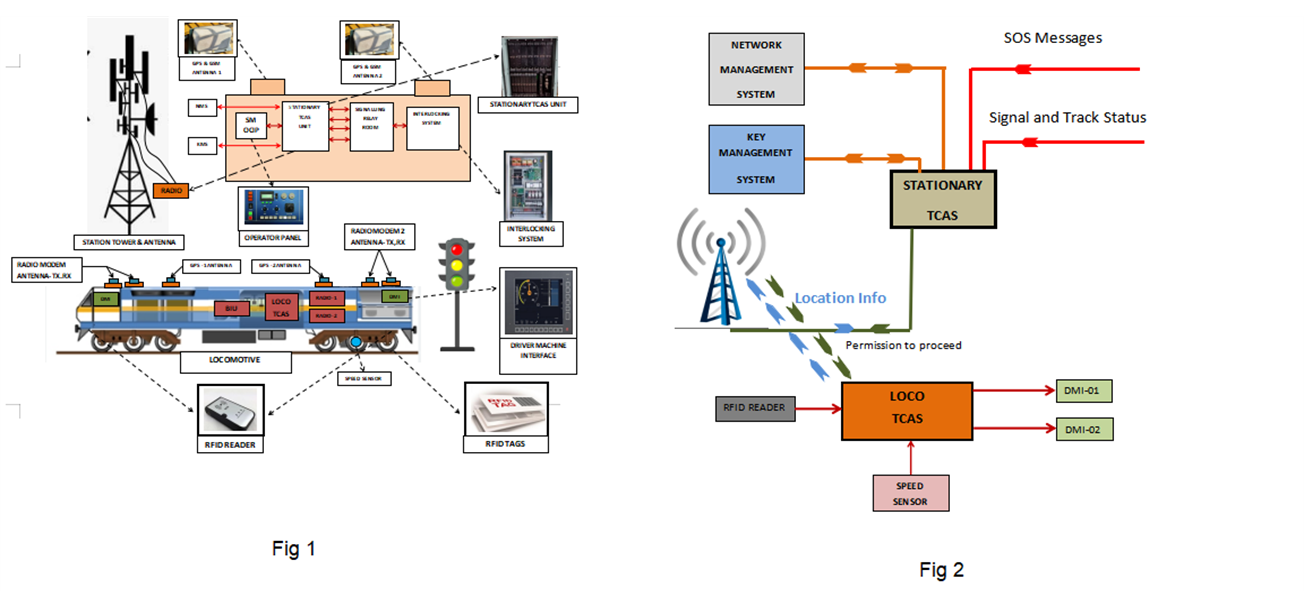Introduction
LAX-TCAS is an indigenously developed Automatic Train Protection (ATP) System designed to safeguard trains against excessive speed, collisions, and Signal Passing at Danger (SPAD). The system continuously updates the Movement Authority, specifying the distance up to which the train can travel without danger. If the crew fails to take appropriate actions, such as applying the brakes, TCAS will automatically initiate the braking process. TCAS displays key information, such as speed, location, signal aspects, and more, in the locomotive driver’s cab. The system also generates automatic and manual SOS (Distress) messages in emergency situations.
The communication between Stationary TCAS and Locomotive TCAS follows Safety Integrity Level (SIL-4) standards, while communication between Loco TCAS units and other non-signaling collision protection features (head-on, rear-end, and side collisions) is non-SIL.
System Overview
The TCAS system is divided into two primary components: the Trackside Sub-System and the Onboard Loco TCAS Sub-System.
The brief overview of functioning of TCAS is as given below:

Trackside Sub-System:
- RFID Tags are placed on the track to provide location and direction data to the Loco TCAS unit.
- Stationary TCAS is installed at the station with a radio tower to communicate with locomotives within the station area.
- Communication: UHF Radio communication is used for the transfer of data, including location, speed, and signal information.
- Configuration: The system interfaces with station interlocking for real-time signal information and uses TCAS Control Tables for route configuration.
- Remote Interface Unit (RIU) is used when remote signaling is needed, e.g., at Level Crossing Gates and Intermediate Block Signaling locations.
Onboard Loco TCAS Sub-System:
- RFID Tags read by the Loco TCAS unit allow the system to calculate the exact position and movement direction of the train.
- Movement Authority is transmitted by the Stationary TCAS based on signal aspect, track status, and route information.
- Speed Profile & Brake Curve: The Loco TCAS system generates a speed profile and brake curve for the train based on movement authority.
- Driver Machine Interface (DMI): The system displays train speed, permitted speed, target distance, and target speed to the locomotive pilot.
- Automatic Braking: If a Red (Danger) signal is detected and the pilot fails to act, the system applies automatic braking to prevent Signal Passing at Danger (SPAD).
Communication:
- Full Duplex UHF Radio Communication: Ensures seamless data exchange between Stationary and Loco TCAS units using TDMA/FDMA communication schemes.
- GSM/GPRS for Centralized Monitoring: The system can transmit critical fault messages and other data to a central server for network-wide monitoring.
Application
- Preventing Train Collisions: Automatic braking and collision avoidance in station sections and block sections.
- Signal Passing at Danger (SPAD): Automatic braking in case of failure to stop at red signals.
- Emergency Situations: The system can broadcast SOS messages to alert other units in case of emergencies (head-on, rear-end collisions, etc.).
- Real-time Monitoring: Continuous monitoring and troubleshooting through a centralized Network Monitoring System (NMS).
Salient Features
| Feature | Details |
|---|---|
| Automatic Braking | Automatic brake application in case of failure to stop at dangerous signals (SPAD) |
| Real-Time Movement Authority Updates | Continuous updates on permitted movement distance, speed, and signal aspects |
| Driver Alerts | Visual (DMI) and audible alerts to driver for speed and signal indications |
| Full Duplex Communication | UHF Radio communication between Stationary and Loco TCAS units with TDMA/FDMA |
| SOS Messaging | Automatic and manual SOS generation in emergencies |
| SIL-4 Communication for Stationary TCAS | High-level safety integrity in communication between Stationary and Loco TCAS units |
| Emergency Collision Protection | Head-on, rear-end, and side collision protection features |
| Network Monitoring | Centralized real-time monitoring and fault diagnostics through Network Monitoring System (NMS) |
| GSM/GPRS Integration | Transmission of critical messages via GSM for secure communication |
Technical specification
| Parameter | Details |
|---|---|
| Power Supply | 50V to 140V DC from locomotive (optional 24V DC as per customer requirement) |
| Communication Interface | Full Duplex UHF Radio Communication, TDMA/FDMA scheme, GSM/GPRS interface for NMS |
| System Integrity | SIL-4 for Stationary TCAS, non-SIL for Loco TCAS communication in emergency scenarios |
| Temperature Range | -5°C to +60°C |
| Data Transmission | UHF Radio Communication for data exchange, encryption using cryptographic techniques |
| Tracking System | RFID Tags and onboard speed sensing for location and direction tracking |
| SOS Functionality | Manual and Auto-generated SOS messages for emergency situations |
| Centralized Monitoring | Network Monitoring System (NMS) for real-time monitoring and troubleshooting |
| Fault Logging & Diagnostics | Real-time logging of faults and events with timestamp for post-analysis and troubleshooting |
